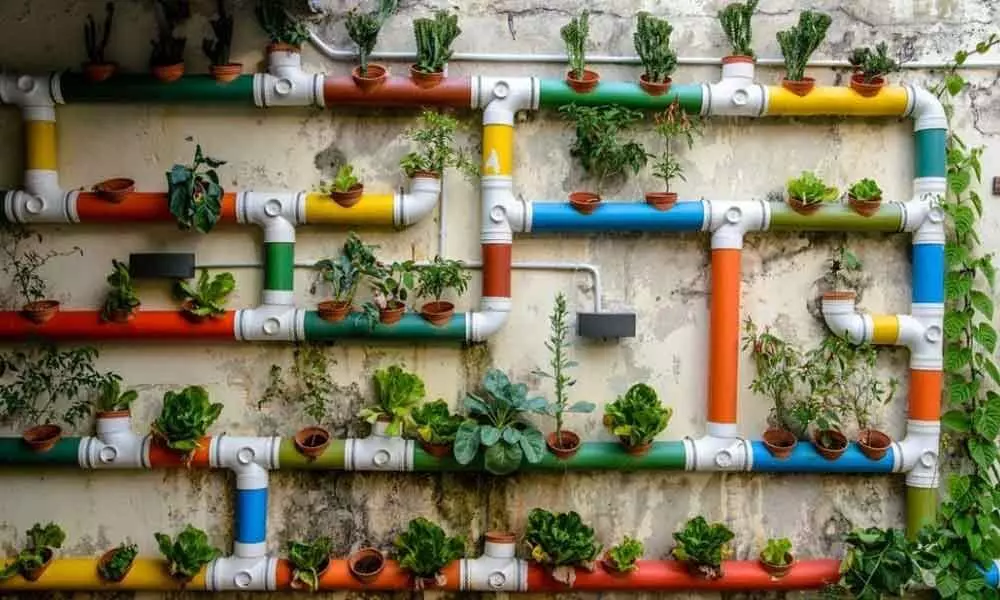Meeting nutritional requirements through urban agriculture

Can climate-controlled freight containers help in farming or can plants grow without any soil? The answers to these questions can be found in Urban farming
Can climate-controlled freight containers help in farming or can plants grow without any soil? The answers to these questions can be found in Urban farming. It involves indoor cultivation under controlled conditions with up to eight harvests in a year.
It offers an ideal solution for regional or community specific food needs, for local crops that would not be economically viable for full scale cultivation. It can also help cities become self-sufficient in their produce demand while getting fresh food the year round. Vertical urban farming whether with soil or hydroponics-based, increases the space utilization by 3-4 fold with lower water and nutrient usage.
Therefore, it allows the farmer to have 3-4 fold higher area with 20 per cent faster growth rate, leading to 3-4 fold higher harvests. Multiple harvests in a year would lead to higher profits compared to traditional farming. Indoor farms may use drip-irrigated pots, hydroponics, aeroponics or hydrogel-based polymers for growing vegetables depending on the growth requirements of the plant.
Conventional farms are resource inefficient as about 70 per cent of nutrients and 60 per cent of the water inputs are lost due to run offs. Further the plant growth is dependent on soil nutrients and environment. Since crops in urban farms are grown in a closed environment, sometime without soil, they have minimal /no exposure to outside environment and pests.
Thus, they require no/minimal pesticide sprays. With lower pesticide usage and transport needs for supplying food, urban farms use lesser fossil fuel. The resource efficient indoor farming that is not overly impacted by the weather is able to provide optimal growth conditions to the plants to maximize the harvest.
The set up uses high-efficiency light source, water re-cycling in minimal space, with low electricity usage leading to a reduced carbon footprint. Special light requirements for indoor farming are now met by several organizations which have enabled higher production and cost reductions over longer period.
Environment controlled containers, greenhouses or poly-houses on land or roof-tops are some of the options for climate resilient urban farming.
The structural design of indoor farming units and turn-over time for efficient harvests have limited it to few compact crops, especially leafy salads. A crop variety suitable for urban farms needs to be small, compact, early flowering and having early maturing fruits. Currently about 65 herbs, micro-greens and leafy greens, including broccoli, Italian Basil, Crystal Lettuce, mint, coriander, tomatoes etc are being grown in indoor farms.
Brahmi, an Ayurvedic traditional medicine used to improve memory and to treat inflammatory diseases, etc. is also being cultivated using hydroponics. Indian urban farmers can expand on their crops if more local crops are bred for compaction and shorter growth cycle. The Indian scientists have the skill and competency to enable urban farmers grow many more crops efficiently, especially in zones with extreme weather and water scarcity.
The digitization of farming has enabled extensive data collection throughout the cultivation cycle. The analysis of the growth and environmental parameters can help design better nutrient regimes, improved growth and faster maturity for crops to maximize output. In indoor farms, these optimizations include temperature, light spectrum and nutrient pH.
Artificial intelligence (AI) can also be used for analysis and better optimizations. These optimizations would lead to improved futuristic design of the farms as well as resource utilization to make them more sustainable.
The produce requirements of large cities, such as Delhi, Mumbai, Bengaluru, are met through supplies from the suburbs and distant locations, therefore, their quality is dependent on storage conditions and the distance travelled. Urban farming can overcome these variables to make cities self-sufficient in their fresh produce.
In India, indoor farming is majorly confined to metros and major cities that have a demand for organically grown farm fresh produce like spinach, mint, lettuce, thyme, basil, tomatoes and strawberries, but many progressive Indian farmers too have turned to urban farming techniques for exotic small crops like broccoli, red and yellow capsicum, cherry tomatoes, etc.
Many nations are growing and exporting indoor farm produce, especially leafy vegetables, fruits and flowers. Pioneer amongst them are the Netherlands, they are the top exporter of potatoes and onions and the second largest exporter of vegetables that are grown in climate controlled indoor farms.
Considering the small set-up requirements, capital and proximity to the market, indoor farming is ideal endeavour for start-ups. In the past decade a dozen such start-ups have come up around major cities in India.
They have got some support from universities, ICAR (Indian Council of Agricultural Research) and organizations like a-IDEA (Association for Innovation Development of Entrepreneurship in Agriculture) and NAARM (National Academy of Agricultural Research Management) in Hyderabad.
Recently, in the US, the USDA has established a new Urban Ag Office and announced USD three million in new grants. In other countries, there are several private companies that provide infrastructure, equipment for indoor farming both for home and a commercial setup. Companies (such as Contain Inc.) are coming up with alternate finance options for indoor growers, for greenhouse or containers.
With the right support from the Government, interest from young agri-tech startups, training programs and greater awareness amongst the urban population regarding the opportunity as well as quality offered by indoor farming, it can gain popularity and contribute to the nutritional needs of the urban India.
(Ratna Kumria, Director, Agri Biotech - Alliance for Agri Innovation and Dr. Shivendra Bajaj, Executive Director, FSII. The Views expressed are personal)

